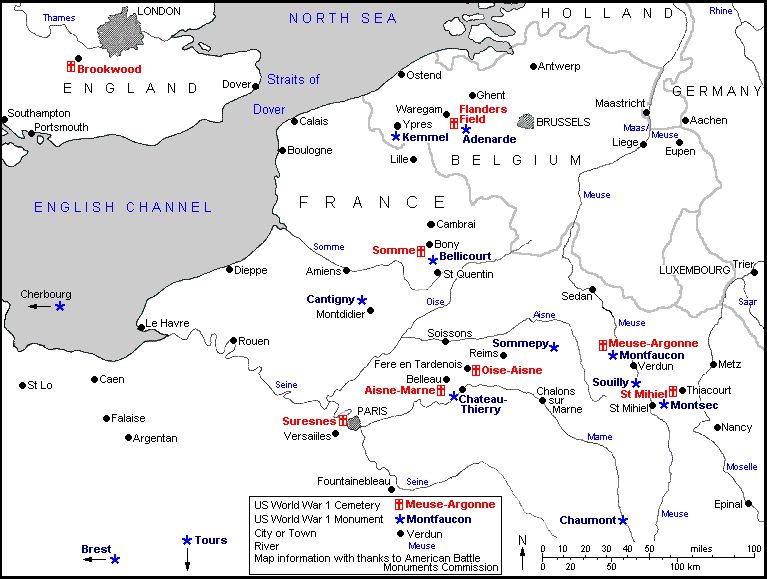Battlefields of WW1
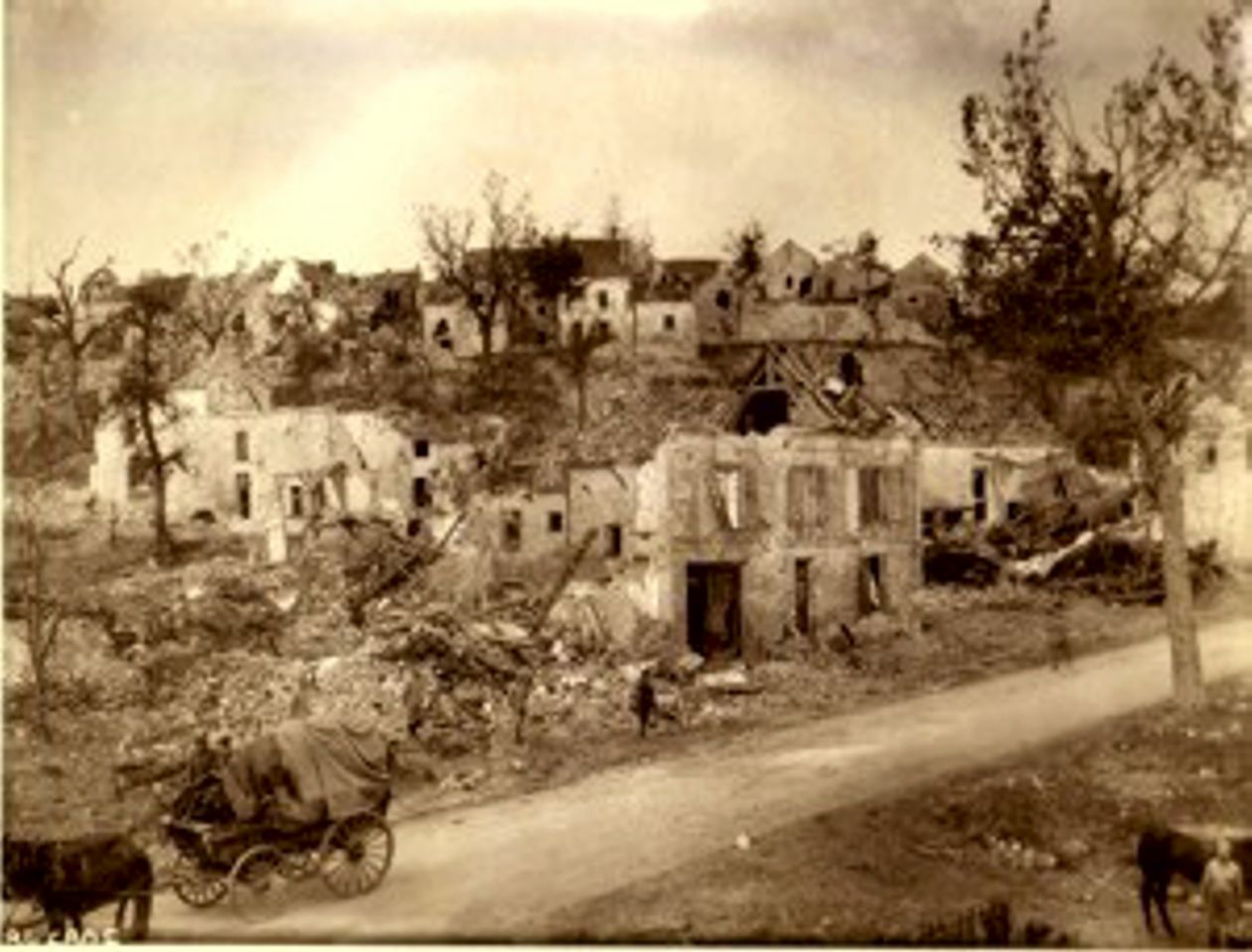
"Men of the 132nd US Infantry, 33rd Division, in a front line trench looking toward the valley of the Meuse, where it is estimated 70,000 men lie buried."
US Official Photo America's War for the Humanities
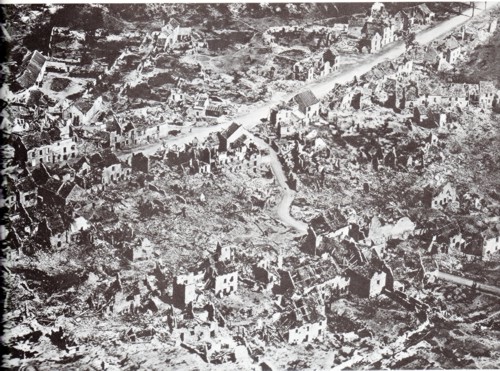
The destruction of Vaux, viewed from the air.
America's War for the Humanities
"No war in recent memory can compare to the meat grinder of World War I.
"Europe still bears the scars of the war, even almost a century later. The gruesome and terrifying type of warfare typical of the Great War had a lasting impact on those who witnessed and experienced it.
"It also created such carnage on the land where it was fought that some of those areas are still uninhabitable to this day."
Munitions were mass-produced which lead to many defects. Many shells fired from both sides did not explode upon impact leaving so many hazards the British organized "Ordinance Examiners" to address the problem.
View of an American cemetery on a battlefield near Toul, France, during World War I, featuring makeshift wooden crosses made from fence posts as grave markers. A grave marker for a Corporal A.C. Copeman is pictured. Caption on back reads in Henry Graves's handwriting: “An American cemetery near Toul, France” (circa 1918) [Photograph taken or collected by Henry L. Graves]. US Army Signal Corps Photo
The following is an approximate number of the American soldiers engaged in various battles:
Noyon-Montdidier, June 9 to 15 27,000
Champagne-Marne, July 15 to 18 85,000
Allied Offensives, July 18 - November 11:
Aisne-Marne, July 18 to August 6 270,000
Somme, August 8 two November 11 54,000
Oisne-Aisne, August 18 to November 11 85,000
Ypres-Lys, August 19 two November 11 108,000
St. Mihiel, September 12 to 16 550,000
Meuse-Argonne, September 20 to November 11 1,200,000
Italian Front - Campaign of 1918
Vittorio-Vento, October 24 to November 4 1,200
West Front - Campaign of 1917
Cambria, November 20 to December 4 (not listed)
West front - Campaign of 1918 (German offensives, March 21 - July 18)
Somme, March 12 to April 6 2,200
Lys, April 9 to 27 500
Aisne, May 27 to June 5 27,500
- Information from: Son's of Men, Evansville's war record compiled by Heiman Blatt, 1930
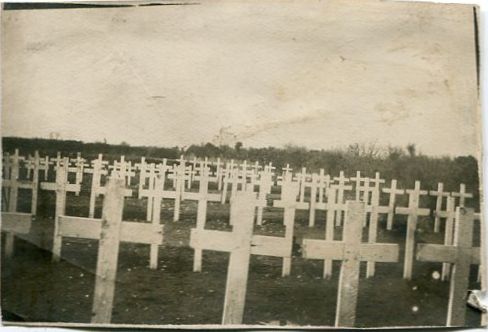
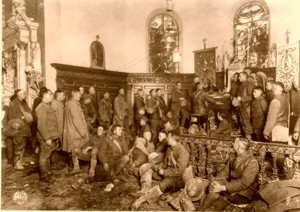
Interior of Church at Vaux with troops of 317th & 319th Ambulance Co's. 305th Sanitary Train at organ singing. Vaux Ardennes, France.
Vaux capture was led by the 23rd Infantry, joined by the 153rd and the French 39th Division. The capture of the town of Vaux helped to wind down the battle of Chateau-Thierry.
National Archives photo 32158, courtesy of Indiana War Memorial
Evansville Courier article quoted in the Son's of Men, by Heiman Blatt
"A gang of seven Evansville boys in Pfaffendorf, Germany, wrote to the courier under the date of January, 28 as follows:
"Here on the banks of the Rhine in a little town just across River from the city of Coblenz, are seven boys from old E-Town. We enlisted at the same time, were sent to Fort Oglethorpe and later transferred to Camp Jackson, South Carolina. Here we made a party of the First Corps Artillery Park, the first organization of its kind in the U.S. Army. It is composed of six truck companies of 150 men each, a depot company of 305 men, (the biggest company in the Army) and ordnance company of 57 skilled mechanics, and Headquarters Company of 48 men and a medical detachment of 1910. After a little over two months of strenuous training, we moved to Camp Merritt, New Jersey. Here we received our first overseas equipment and on May 22 sailed on the Great Northern. After a dandy trip, not even getting a peek at a sub, we landed in Brest, France, on decoration Day. We hiked to the city out to the old prison camp of Napoleon Bonaparte. In this delightful (?) camp we spent almost a week and that we were loaded on the 'quarante hommes or haute chauvaux" cars and the following day we were pulled into St. Nazaire.
"Our home here was a French rest camp but while we were resting, we were taught the art of unloading ships. But we only had five days of this and were again ordered to move, this time on fourth class coaches. This was a four-day ride through the most beautiful part of France.
"On July 13 we left for the Château-Thierry front and prepared for action. Having about 300 trucks, we were ready to start handling ammunition as we found out that would be our part in the great war. On July 14 we passed to Paris and saw the city decorated up for Bastille Day. The next day we got into La Ferte and started right into the action. Then the great drive started on the Marne and then the big show was on. Our trucks hauled ammunition day and night and our Depot Company opened several dumps between the heavy and light artillery. We, the medical detachment, were stationed at different places in open infirmaries and first aid stations. Our ammunition dumps were under shell fire at all times and Fritz tried his best to get us time after time with this Aero planes. We passed to the city of Château Thierry while the dead were dying in the streets everywhere. It was assigned we shall never forget. We had dumps at Bezu, St. Germain, Epid, Epaun-Bizu, Belleau Wood, Fere-en-Tardenois, and up as far as Fismes on the Vesle River.
"We came through this drive with very few casualties and considered ourselves very lucky. On September 10 we were called out and all expected a good rest. We were loaded onto our trucks and for two days and nights, rode through the pouring rain. The end of our trip found us in a woods near the city of Verdun with mud up to our knees. After a few days rest and an attempt to rid ourselves of our numerous cooties, we started once more hauling ammunition. We had a chance to see the city of Verdun and see some of the work of the Huns. On September 25, the real American drive started on the Argonne-Meuse sector. We had our ammunition dumps at the town of Germanville. With several hundred French 75's and six-inch guns we put on one of the best barrages ever heard of.
"Fritz came back at us with an awful gas attack but did very little damage. Then in two days, our trucks were crawling over the roads the engineers were building over what had been 'no man's land' for four years. We moved our dumps up through Esnes, Mallancourt, Cuisy, Sept, Serges and up along the Meuse River to Dun-Sun-Meuse. In this drive, we had quite a few casualties and while we had our dump in the valley near Cuisy our dump was shelled day and night, they came near putting us off the map several times. Then just as the drive was at its height, one of the fellows from E-town, John Webster, after dodging shells and bombs for a month, took the 'flu' and several days later died and is resting a little American cemetery in a quiet town behind the lines.
"As a reward for our good work we were made part of the Army of occupation. On December 14, we crossed the Rhine and Coblenz being the first whole unit across that river. We have now passed to Coblenz and have seen about all there is to be seen. The YMCA has taken over the Festhalle in Coblenz and has good shows in dances almost every night. Last night we had the pleasure of seeing Miss Gould and she sure made us think of the good old USA. The question here is, 'When do we get home?'
But all the real fighting divisions are here, including 1, 2, 3, 4, 4, 26, 32, 42, 89, and 90 so you may know we will make some excitement when we do get home. Here's hoping it won't be long."
John E Sitzman, Louis R. Bohrer, Edgar J Mentzel, O. Vernon Weldon, Fred A. Heeger, E. W. Janderbeaur and A. S. Moutichka,
the Evansville "E-Town Gang.
"A British NCO prepares to dispose of an unexploded bomb, during the First World War."
By John Warwick Brooke - 1918 edition of "The War Pictorial" magazine IWM (Q 6017)This is photograph Q 6017 from the collections of the Imperial War Museums., Public Domain, https://commons.wikimedia.org/w/index.php?curid=2844219
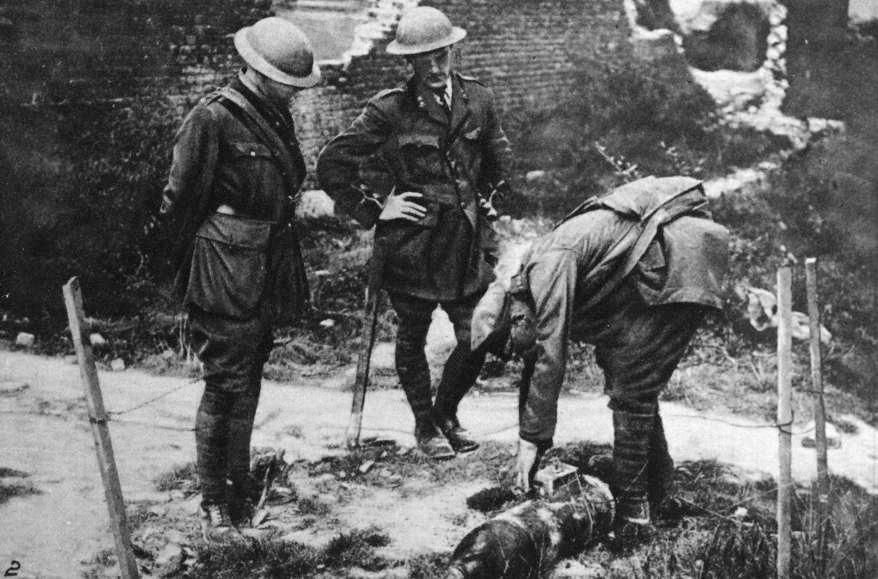
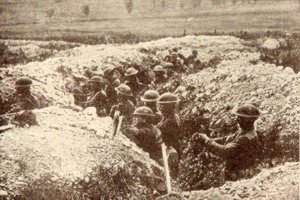
The Meuse-Argonne was one of the final allied offensives of WW1. Over 1,200,000 million American soldiers fought in this battle from September 26, 1918, through the Armistice, November 11, 1918, 47 days.
"Men of the 132nd US Infantry, 33rd Division, in a front line trench looking toward the valley of the Meuse, where it is estimated 70,000 men lie buried."
US Official Photo, America's War for the Humanities
Meuse-Argonne
It remains the largest offensive the US was involved in and the second deadliest with the loss of 350,000 soldiers, 26,277 Americans. 95,786 American soldiers were injured, a casualty rate of 10%. Many of the US troops suffered due to inexperience and the global pandemic of the Spanish Flu. The terrain of the Argonne forest limited visibility to 20 feet but the 42nd Division was forced over open ground to assault the German line. MacArthur was constantly at the front line. The infantry divisions lost two-thirds of their fighting strength on the first day of fighting. The battle only ended because the Armistice was declared,
Chateau-Thierry
National Archives photo 17594 courtesy of Indiana War Memorial.
The ruins of the Chateau.
The Chateau was originally constructed by Charles Martel in 720 as a residence for the adolescent Meroving king Theodoric. It was leveled in 1060 and the present ruins were rebuilt between 1220 to 1230. It was adapted for military use in the 15th century. It was captured by the English in 1420 and in 1544 was retaken by Charles V. It fell into ruin as a subsidiary castle to the La Tour d'Auvergne family.
The WW1 battle was fought in mid-1918 under the leadership of General John J. (Black Jack) Pershing. The US troops consisted of Army and Marine units barely out of training. The German forces lead the attack, attempting to take advantage of the inexperienced US troops. Under Pershing's leadership, the Allies replied without the customary Artillery bombardment, going silently "over the top". US machine gunners helped save the US and French troops forcing the German retreat. The Germans lost 5,300 men and the Allied losses were just over 1,900.

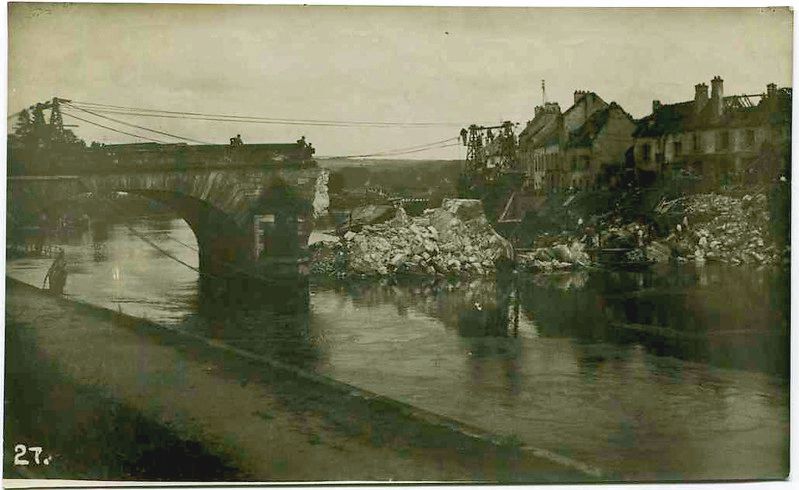
View of a destroyed bridge over a waterway [believed to be the Marne River] at Château-Thierry, France, during World War I. Caption on back reads: A destroyed bridge at Chateau Thierry” US Signal Corps photo
Aisne, France
"Esne from Cemetery Hill 300, which was held by the Germans since the beginning of the War. Many lives were lost on this hill."
National Archives photo courtesy of Indiana War Memorial
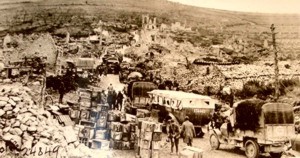
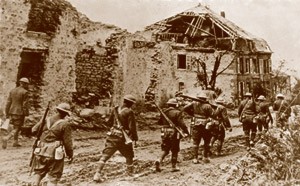
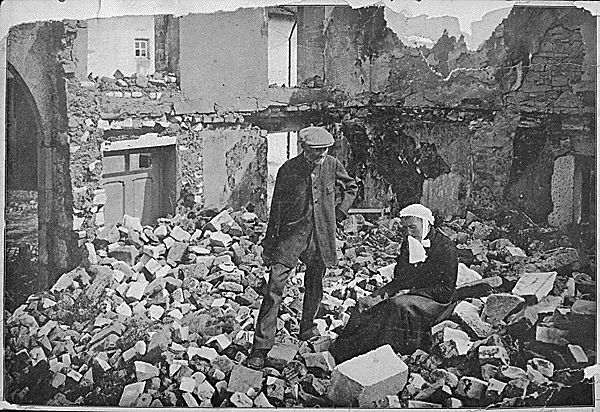
Home Again. An old French couple visiting their former house in the devastated region, vacated by the Germans, find a mass of stone and debris, representing what was once home to them. Halftone from Le Monde Illustre. National Archives Photo
The battle of Verdun
The longest battle of WW1, fought from February through December 1916 and most costly in history. Over 800,000 men were lost on all sides. The US had not declared war but American volunteers performed an essential service providing fighter pilots and 2,500 ambulance drivers. 127 ambulance drivers were killed evacuating over 400,000 French wounded. Their efficiency and combat protocols they established served as a standard for the US army for years.
US pilots, anxious to join the "action", had volunteered for the Lafayette Escadrille that was established in 1916. A monument in the Place des États-Unis, Paris stands to commemorate the American volunteers who fought for France in WW1.
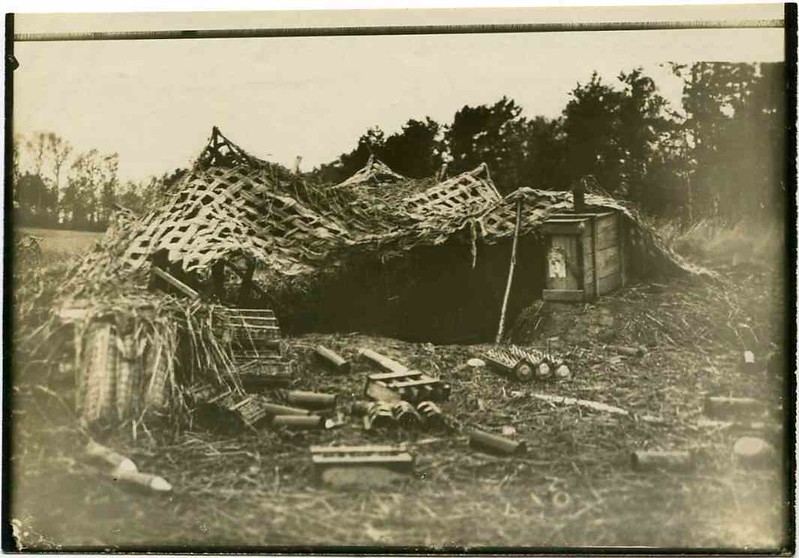
Contact print from a negative of an image showing a camouflaged dugout, surrounded by empty artillery shells littering the ground around the dugout, south of Verdun, France, during World War I (circa 1918)
Photograph taken or collected by Henry L. Graves. US Signal Corps photo
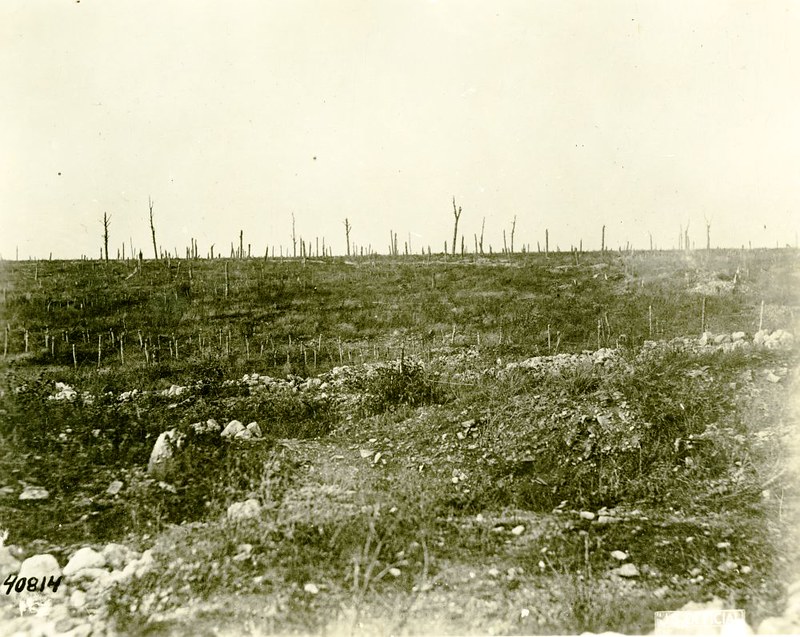
Remains of a forest on Verdun-Metz Road. From the Captain Albert T. Willis Collection, 1917-1919, PhC.21; World War I scenes in England and France associated with the 322nd Infantry and 81st Division, 1917-1919.
US Signal Corps Photo
To see actual World War 1 film footage of the St. Mihiel drive from the National Archives:
https://youtu.be/dJfWyn53-QI?list=PLugwVCjzrJsXXtUE4J64ZH8xeXcg_FOZ9
Saint Mihiel, France
The first large offensive involving the United States Troops. They accompanying the 110,00 French troops and were led by General John J. Pershing.
Capturing St Mihiel Salient. American Engineers return from the front through the shell-torn town of Nonsard.
National Archives photos courtesy of Indiana War Memorial
See: https://en.wikipedia.org/wiki/Battle_of_Saint-Mihiel
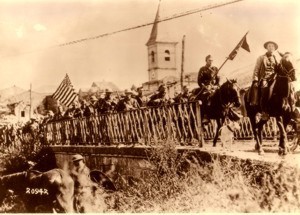
Saint-Mihiel was taken by the newly arrived and activated American 1st Army. The Germans had possession of the area for two successive campaigns but began withdrawing on September 11, 1918. 16 American Divisions lead by General Pershing with aid from French artillery, tanks, and air. The air force was made of mixed units and under the command of Col. William Mitchel. Within 36 hours the surprised German forces were driven out with a loss of 15,000 prisoners and more than 250 guns left behind. Pershing suffered 5,000 casualties.
The Western Front
The ancient Belgium city of Ypres was the site of three battles of WW1 and is remembered as the first use of gas by the Germans in the first battle. In August and September, the 27th and 30th Divisions confronted the Germans. The enemy was atop the highest point in the area, Kemmel Hill giving them an advantage over the American and British 2nd Army who were operating under British Field Marshal Douglas Haig.
After intense fighting from German trench mortars and machine guns and "friendly fire" exacerbated by the topography, the Germans retreated. The 30th Division had taken one square mile. inflicted 100 German casualties and captured 16 prisoners. machine guns and ammunition. The 30th lost two officers and thirty-five men were killed.
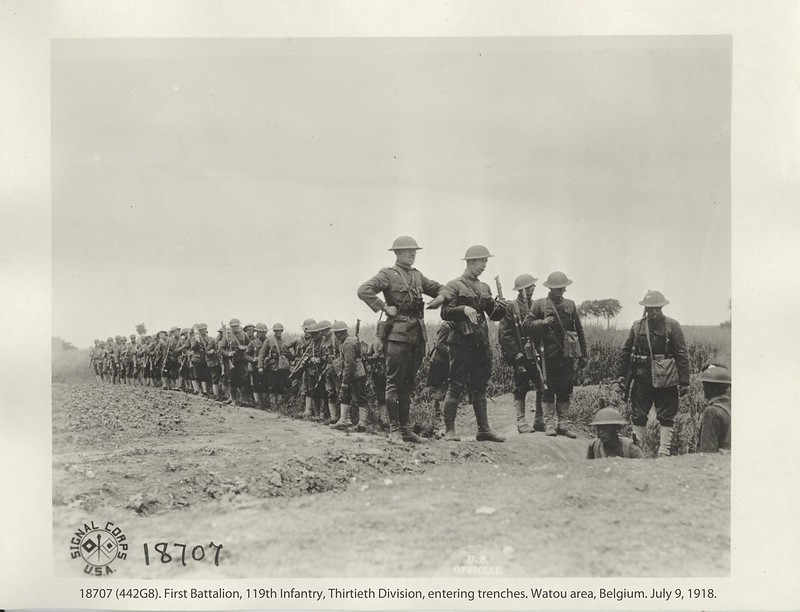
View of the 1st Battalion, 119th Infantry, 30th Division, entering the trenches in the Watou area of Belgium on July 9, 1918. US Army Signal Corps Photo
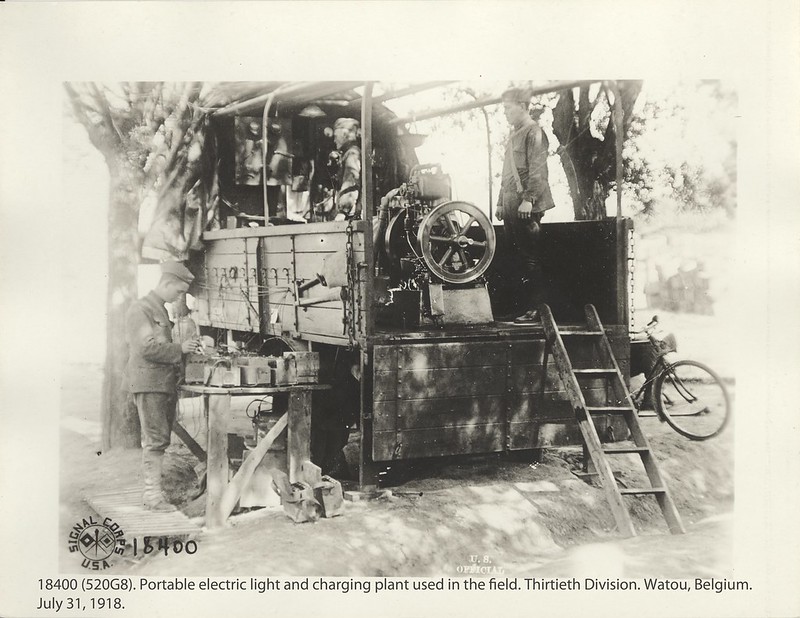
View of a portable-electric-light and charging plant used by the 30th Division in the field during battle taken while the division was stationed in Watou, Belgium on July 31 1918 US Army Signal Corps Photo
US cemeteries and monuments in Europe
https://www.naval-history.net/WW1NavyUSMC-CasualtiesAlpha2.htm
